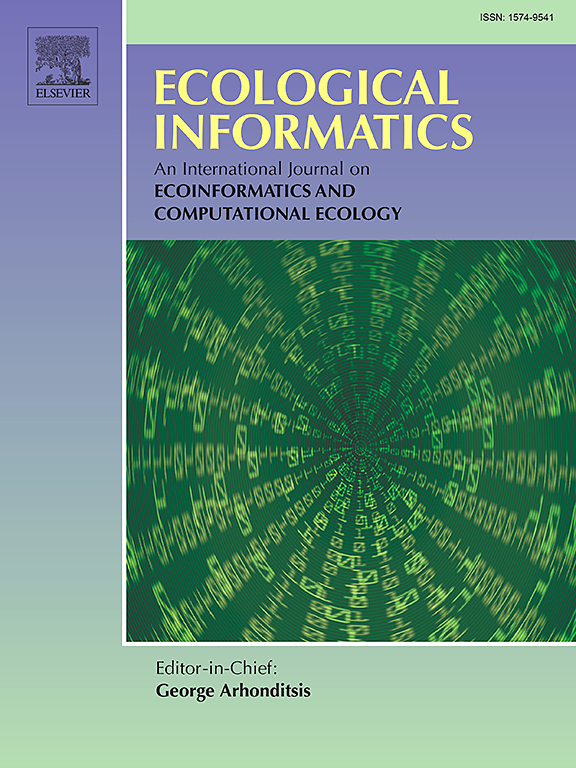Montrends:一个谷歌地球引擎应用程序,用于分析物种随时间的栖息地适应性
IF 7.3
2区 环境科学与生态学
Q1 ECOLOGY
引用次数: 0
摘要
人类活动正在影响世界范围内的生物多样性。生物多样性监测对于评估和支持保护现状和趋势至关重要。遥感在支持生物多样性监测方面发挥了至关重要的作用,但仍需要更直观和快速的处理工具来改善生物多样性保护。在此,我们提出了一个谷歌Earth Engine (GEE) App,名为Montreds,它实现了一个生物多样性监测工具,通过计算卫星产品时间序列的生态位模型(enm)来测量物种栖息地适宜性随时间的变化趋势。该申请是针对蒙特西尼奥自然公园/诺盖拉特别保护区的,这是一个位于葡萄牙东北部的保护区。该应用程序使用2001年至2023年间六个中等分辨率成像光谱仪(MODIS)产品的时间序列,使用MaxEnt计算五个分类群(维管植物、两栖动物、爬行动物、鸟类和哺乳动物)的enm随时间变化。使用Mann-Kendall检验估计生境适宜性趋势。Montrends的主要输出是每个模型物种随时间的正、负或零趋势的地图。如果生境适宜性随时间单调下降,则趋势为负。该应用程序允许用户选择要建模的物种、时间周期、模型复制的数量以及训练和测试记录的比例。应用程序在大约一分钟内直观地运行分析。结果包括:整个研究区的平均MaxEnt模型随时间的变化趋势和Mann-Kendall趋势,物种的存在,具有显著趋势的像元,以及物种在显著像元中的出现情况。该应用程序还提供了主要的MaxEnt输出,包括曲线下面积(AUC)值和变量贡献,预测变量随时间的全局贡献图,平均趋势值和MaxEnt参数信息。决策者和保护规划者可以将此应用程序作为生物多样性监测和保护的补充工具。本文章由计算机程序翻译,如有差异,请以英文原文为准。
Montrends: A Google Earth engine application for analysing species' habitat suitability over time
Human activities are impacting biodiversity worldwide. Biodiversity monitoring is essential to assess and support conservation status and trends. Remote sensing has played a crucial role in supporting biodiversity monitoring, but more intuitive and fast-processing tools are still required to improve biodiversity conservation. Herein, we present a Google Earth Engine (GEE) App called Montreds, which implements a biodiversity monitoring tool to measure trends in species habitat suitability over time by calculating ecological niche models (ENMs) with a time series of satellite products. The application is specific to Montesinho Natural Park/Nogueira Special Conservation Area, a protected area located in northeastern Portugal. The application calculates ENMs over time with MaxEnt for five taxa (vascular plants, amphibians, reptiles, birds, and mammals), using a time series of six Moderate-Resolution Imaging Spectroradiometer (MODIS) products between 2001 and 2023. Habitat suitability trends are estimated using the Mann-Kendall test. The Montrends' main output is a map for each modelled species with positive, negative, or null trends over time. If habitat suitability decreases monotonically over time, the trend is identified as negative. The application allows the users to select the species to be modelled, the temporal period, the number of model replicates, and the proportion of training and test records. The application runs the analyses intuitively in about a minute. Several results are displayed: the mean MaxEnt model over time and the Mann-Kendall trends for the whole study area, the species presences, the pixels with significant trends, and the species' occurrences in significant pixels. The application also provides the main MaxEnt outputs, including Area Under the Curve (AUC) values and variable contributions, plots of the global contributions of predictor variables over time, average trend values, and information on MaxEnt parameters. Decision-makers and conservation planners can use this application as a complementary tool for biodiversity monitoring and conservation.
求助全文
通过发布文献求助,成功后即可免费获取论文全文。
去求助
来源期刊

Ecological Informatics
环境科学-生态学
CiteScore
8.30
自引率
11.80%
发文量
346
审稿时长
46 days
期刊介绍:
The journal Ecological Informatics is devoted to the publication of high quality, peer-reviewed articles on all aspects of computational ecology, data science and biogeography. The scope of the journal takes into account the data-intensive nature of ecology, the growing capacity of information technology to access, harness and leverage complex data as well as the critical need for informing sustainable management in view of global environmental and climate change.
The nature of the journal is interdisciplinary at the crossover between ecology and informatics. It focuses on novel concepts and techniques for image- and genome-based monitoring and interpretation, sensor- and multimedia-based data acquisition, internet-based data archiving and sharing, data assimilation, modelling and prediction of ecological data.
 求助内容:
求助内容: 应助结果提醒方式:
应助结果提醒方式:


